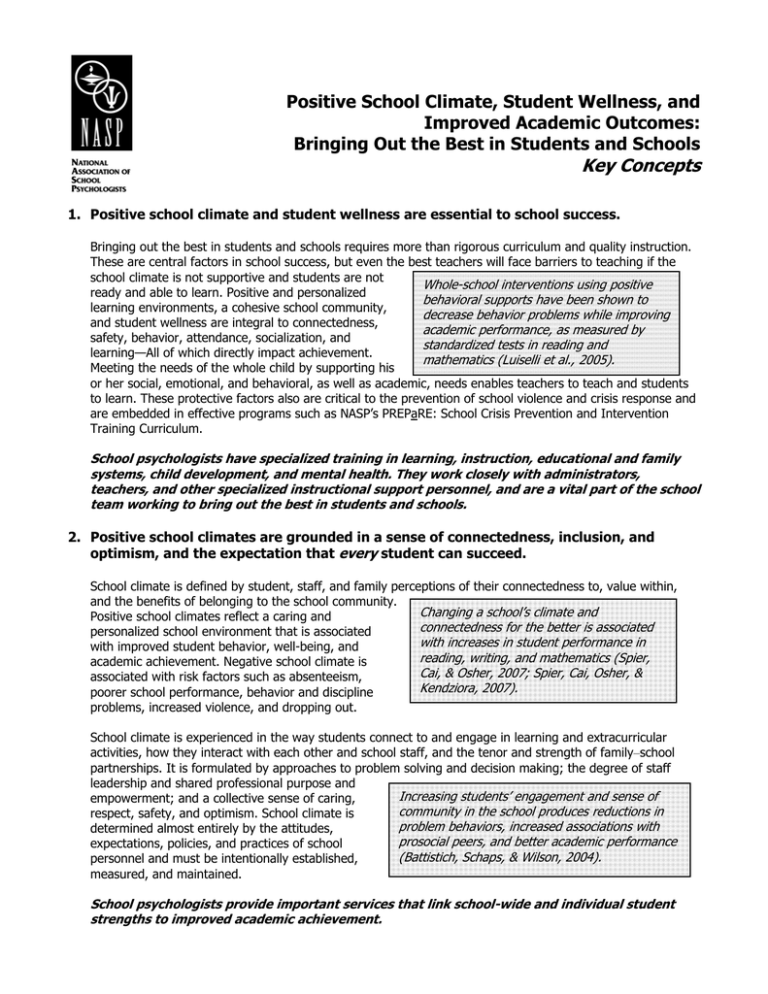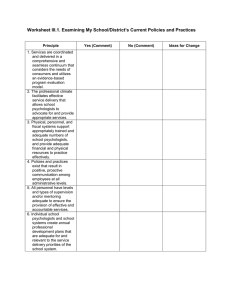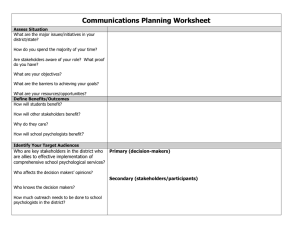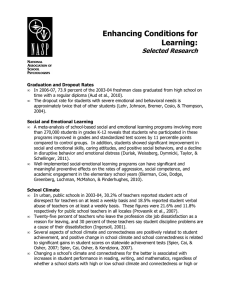Document 10883586
advertisement

Positive School Climate, Student Wellness, and Improved Academic Outcomes: Bringing Out the Best in Students and Schools Key Concepts 1. Positive school climate and student wellness are essential to school success. Bringing out the best in students and schools requires more than rigorous curriculum and quality instruction. These are central factors in school success, but even the best teachers will face barriers to teaching if the school climate is not supportive and students are not Whole-school interventions using positive ready and able to learn. Positive and personalized behavioral supports have been shown to learning environments, a cohesive school community, decrease behavior problems while improving and student wellness are integral to connectedness, academic performance, as measured by safety, behavior, attendance, socialization, and standardized tests in reading and learning—All of which directly impact achievement. mathematics (Luiselli et al., 2005). Meeting the needs of the whole child by supporting his or her social, emotional, and behavioral, as well as academic, needs enables teachers to teach and students to learn. These protective factors also are critical to the prevention of school violence and crisis response and are embedded in effective programs such as NASP’s PREPaRE: School Crisis Prevention and Intervention Training Curriculum. School psychologists have specialized training in learning, instruction, educational and family systems, child development, and mental health. They work closely with administrators, teachers, and other specialized instructional support personnel, and are a vital part of the school team working to bring out the best in students and schools. 2. Positive school climates are grounded in a sense of connectedness, inclusion, and optimism, and the expectation that every student can succeed. School climate is defined by student, staff, and family perceptions of their connectedness to, value within, and the benefits of belonging to the school community. Changing a school’s climate and Positive school climates reflect a caring and connectedness for the better is associated personalized school environment that is associated with increases in student performance in with improved student behavior, well-being, and reading, writing, and mathematics (Spier, academic achievement. Negative school climate is Cai, & Osher, 2007; Spier, Cai, Osher, & associated with risk factors such as absenteeism, Kendziora, 2007). poorer school performance, behavior and discipline problems, increased violence, and dropping out. School climate is experienced in the way students connect to and engage in learning and extracurricular activities, how they interact with each other and school staff, and the tenor and strength of family–school partnerships. It is formulated by approaches to problem solving and decision making; the degree of staff leadership and shared professional purpose and Increasing students’ engagement and sense of empowerment; and a collective sense of caring, community in the school produces reductions in respect, safety, and optimism. School climate is problem behaviors, increased associations with determined almost entirely by the attitudes, prosocial peers, and better academic performance expectations, policies, and practices of school (Battistich, Schaps, & Wilson, 2004). personnel and must be intentionally established, measured, and maintained. School psychologists provide important services that link school-wide and individual student strengths to improved academic achievement. 3. Schools must set as a priority implementing the practical, time-tested, and researchbased programs and strategies that support positive school climates. Effective strategies both minimize risk factors and A 2005 survey revealed that 53% of teachers negative behaviors and strengthen protective factors see bullying and harassment of students as a and skills development for positive behaviors. Positive serous problem at their schools and that 65% behavioral supports (PBS) is a school-wide program of teens were verbally or physically harassed that has shown consistent positive effects on student or assaulted because of their appearance, behavior and discipline, school climate, and academic gender, sexual orientation, race/ethnicity, achievement. Similarly, school-wide programs that disability, or religion (Harris Interactive, Inc., prevent bullying and harassment provide a critical 2005). foundation for all school safety efforts; decrease negative outcomes such as absenteeism, depression, and suicidal behavior; and are central to positive school climates. School engagement programs such as “Check and Connect” are long proven to decrease delinquency and drop out rates. School psychologists help school leaders and staff to identify and implement evidence-based programs that meet the specific needs of the school community. 4. Family–school partnerships form an essential bond that improves student connectedness, resilience, and achievement. Parent engagement is a priority in almost every area of education and is a major responsibility for school staff. The family–school partnership is essential to the Numerous research studies have indicated health of the overall school community and to the that parental involvement is associated with success of individual students, and the presence of higher student achievement outcomes parents in schools helps make important cultural and (Jeynes, 2005). community connections. In general, children and youth need parent engagement in school and their education in order to achieve. Parents are key players in helping to support and reinforce their child’s academic achievement and social–emotional development. School psychologists advocate for increased home–school collaboration and identify strategies to encourage family participation. 5. Schools can promote students’ physical and mental wellness with a positive, strengthsbased approach that emphasizes optimism and resilience while also meeting specific student needs. By fostering positive relationships among students and adults, and by offering programs and services that meet the needs of the whole child, schools can promote healthy learning and development. Effective student supports that promote wellness include mental health Resilience results from positive social services, emphasize prevention and early intervention, relationships, positive attitudes and actively engage families, and incorporate strength-based emotions, the ability to control one’s own approaches such as positive behavioral supports, social– behavior, and feelings of competence emotional learning, and response to intervention. Schools are (Doll, Zucker, & Brehm, 2004). ideal environments to enrich students’ protective factors by incorporating research-based, skill-building strategies into the curriculum. Examples include NASP’s Gratitude Works program and the Fishful Thinking program (developed by the University of Pennsylvania and Pepperidge Farm), which give teachers and parents simple tools and strategies to promote resilience, optimism, and competence by helping children and youth see the possibilities in themselves and others. Access to student supports directly assists teachers, administrators, and families, and improves school outcomes. School psychologists help foster positive attitudes, positive behaviors, and resilience in children by providing research-based activities and interventions. For more information, visit www.nasponline.org/advocacy. References cited available in briefing handouts. © 2009 National Association of School Psychologists, 4340 East West Highway, Suite 402, Bethesda, MD 20814—(301) 657-0270.





